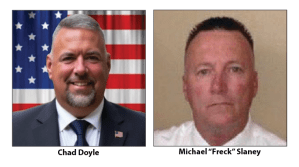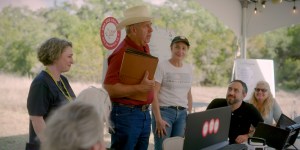One year later: Region nowhere close to being fully recovered
Published 9:00 pm Thursday, August 26, 2021

- (Rick Hickman / American Press)
Friday marks the one-year anniversary of Hurricane Laura’s Category 4 winds wreaking havoc on Southwest Louisiana. Gov. John Bel Edwards and FEMA Administrator Deanne Criswell acknowledged during a visit to Lake Charles Thursday that the region is nowhere close to being fully recovered.
At the same time, Edwards and Criswell urged residents to prepare now for Tropical Storm Ida, which is forecast to make landfall as a hurricane as early as late Sunday.
Edwards and Criswell discussed hurricane recovery efforts with officials in Lake Charles and got a first-hand look at the devastation that remains easily visible throughout Lake Charles and surrounding communities.
Trending
The major hurdle remains providing Southwest Louisiana with the federal disaster supplemental aid it needs to boost long-term recovery. Edwards said the state has demonstrated to federal officials $3 billion in unmet needs from the hurricanes, much of that being housing. Typically, about half of that would be funded through the Community Development Block Grant disaster recovery program, he said.
“If that happens, and we hope/believe that it will, that has tremendous impact,” Edwards said.
Edwards said the CDBG funding could pay for a robust housing program. He said an announcement on a housing effort that combines state and city dollars is anticipated soon, but it will be “relatively small” compared to what is actually needed.
Lake Charles Mayor Nic Hunter said the lack of supplemental disaster aid for the community following four federally-declared natural disasters within a year’s time is “glaring, unacceptable and embarrassing.” He said disaster aid was provided 10 days after Hurricane Katrina’s 2005 landfall and 34 days after Hurricane Andrew’s 1992 landfall.
“What do we have today — zero,” Hunter said.
Criswell acknowledged the frustration residents are feeling one year after Laura’s landfall, but she said recovery takes time. Nearly 24 million cubic yards of hurricane debris have been collected, enough to fill the Caesars Superdome in New Orleans six times, she said. Criswell added that close to 2,400 households have been placed in FEMA trailers until they can find a more permanent housing solution.
Trending
“We all have a shared goal of building a more resilient Lake Charles,” Criswell said.
Edwards mentioned the $1.3 billion in relief being made available in different avenues, including the Small Business Administration, individual assistance and public assistance grants. He said the state has been awarded $236 million through the Hazard Mitigation Grant Program, with $112 million going to Calcasieu Parish.
“Having said that, we’re not recovered; not by a long shot,” Edwards said.
Hunter thanked FEMA and the Louisiana National Guard for their help in the hours and days before and after Laura’s landfall. The current overarching emotion, however, is “a bit of a somber one,” especially when looking at long-term recovery.
Hunter mentioned a request by local officials and Edwards for a cost-share adjustment so the local government can provide more services. That can be done with a signature from President Joe Biden, he said.
“We plead with him to provide that,” Hunter said.
Hunter said individual assistance through FEMA is “one of the only trickles of hope” and source of relief the most vulnerable in the community have received. He said residents should be able to visit with a FEMA representative in person to make sure they are awarded fair and equitable amounts. Criswell said face-to-face meetings are currently possible.
Edwards said the prospect of sheltering thousands of residents at the height of the fourth COVID-19 surge is very daunting. He urged residents to get vaccinated, especially because the Delta variant accounts for 100 percent of the state’s current COVID-19 cases.
To learn more about hurricane preparedness, visit getagameplan.org.






